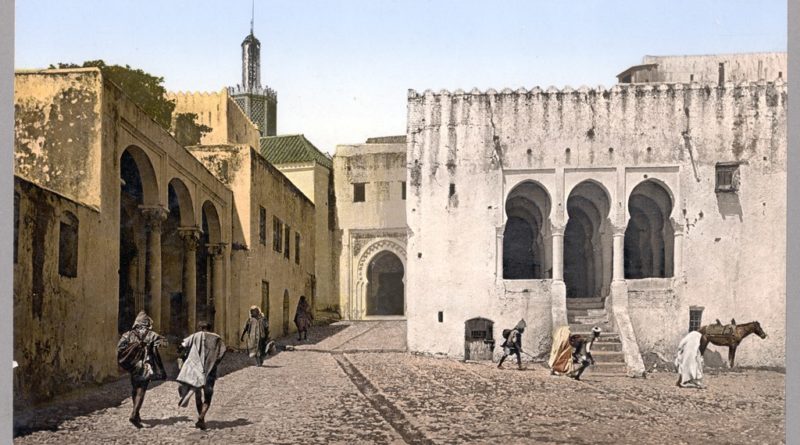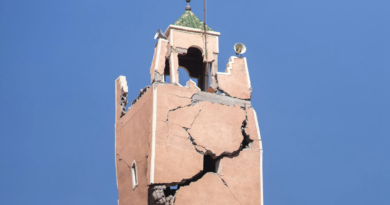Tangier, Myth and Reality
Author: Dr. Karim Bejjit, Professor of English and American Studies, Abdelmalek Essaadi University, Tetouan. Republished with permission.
Over centuries, Tangier had constituted the battleground for different warring races and nationalities. Indeed, the history of the city stretches back to the Greeks and lapses into myth. The legend has it that Antaeus, the offspring of a union between Neptune and Earth, lived in its vicinity. His towering height and invincible force ultimately proved mortal when, in a fight, Hercules lifted him off the ground, wherein the source of his energy lay, and crushed him down. Hercules took the giant’s widow Tingé for a wife and gave birth to a son, Sophax, who in memory of his mother built the city of Tingé. For its protection, the legend goes, Hercules broke asunder the chain of mountains which had united Europe and Africa, causing a sea to flow between them.1
As one moves from legend to documented history, Tangier’s reputation takes on a worldly dimension. Early mention of the city is often traced back in the writings of Hecataeus of Miletus, Herodotus, Hanno the Carthaginian, Scylax, Alexander Polyhistor, Strabon, Pompnivs Mela, Plinivs, Ptolemy, Antonini, Ravennensis, and Plato.2 These scanty references that survive today are far from being adequate or satisfactory to formulate a definite idea of Tangier’s antiquity which otherwise remains largely in the realm of conjecture. Nevertheless, the city’s changing appellations — Tingé, Tingis, Tanja, Tanger, Tangier or Tangiers bear witness to the successive imperial dynasties of whose dominions it constituted a vital part. The city’s long colonial history is presumed to have dated back to the fifteenth century BC, when a trading post was established in its neighbourhood, along with several others on the Atlantic coast by the Phoenicians.3 Around the sixth century BC, Tangier itself was set up as a commercial outpost by the Carthaginians. In 82 BC, it came to pass under Roman colonial rule as Tingis. In 38 BC, it was raised to the status of a free city by the Emperor Octavius, and in 42 AD, it was further adorned with the prestigious title of the capital of the Roman province in North Africa whose name, modelled on Tingis, became Mauritania Tingitana, as different from Mauritania Caesariensis.4
In 429 AD, Tingis was devastated by a Vandal army and served as their base for occupying the rest of North Africa, which they accomplished in ten years.5 Although the Romans took possession of Ceuta and occupied villages on the Mediterranean coast of Morocco, they failed to recapture Tangier which, until the advent of Arab conquest, was governed by a series of indigenous rulers. In 707, Tangier fell to Arab invaders whereupon a converted Berber, Tarik Ibn Zayad was appointed its governor. As in former times, the city operated as a military base for further Arab conquests south in Morocco and north in the Iberian Peninsula. As the Islamic jurisdiction was established in these territories, Tangier’s strategic importance gradually diminished. The next few centuries saw its splendour eclipsed by that of other Moroccan cities, notably Fés and Marrakesh which had become the capitals of a series of powerful dynasties – the Idrissids, Almoravids, Almohads and Almarinids.6

A rather turbulent epoch was awaiting Tangier in the centuries that followed. The consolidation of power in Portugal after the ascendancy to the throne of King Joao of Aviz towards the end of the fourteenth century hailed an unprecedented age of economic prosperity and maritime activities. Motivated by a crusading enterprise, the Portuguese succeeded in capturing and occupying Ceuta in 1415, El Ksar Eseguir in 1452, Asila and Tangier in 1471. In subsequent decades, they established further outposts on the Atlantic coast of Morocco and achieved a control over the trade opportunities and sea traffic of the country.7 However, after their catastrophic defeat in the Battle of Elksar el Kebir in 1578 by a Moroccan army, the Portuguese lost their crown to the Spanish. As a natural sequel, their long acquired colonies on the Moroccan shores, including Tangier were, in turn, ceded to Spain.
In 1643 the Portuguese colonists in Tangier rose in support of the Duke of Braganza, who later became King Joao IV, and succeeded in overthrowing Spanish rule in the city. Although Tangier was alone of the former Portuguese colonies in Morocco to achieve its independence from the Spanish crown, its position soon proved extremely precarious as it underwent a regular Spanish blockade from the sea, and a series of land attacks launched by neighbouring Moroccan tribes. By the 1650s, it became evident that the Portuguese hold over the city was difficult to maintain without a powerful ally to withstand the military pressures of the Spanish government.8 The relief of the city was to come from a distant source. Upon the restoration of Charles II to the British throne in 1660, secret negotiations were conducted in London over an offer of marriage of the Portuguese infanta, Catherine of Braganza to the restored monarch. The Portuguese offer involved a large dowry guaranteeing beside a sum of 300.000l, the cessation to the British crown of Bombay and Tangier, and various commercial advantages in Africa, Brazil and the Far East.9
Thus, for the next two decades, Tangier remained under British control, protected by a ring of redoubts and forts, and defended by a garrison consisting of at least two-thousand regular soldiers and, in critical times, the double of this number. For the prosperity of the colony, a Royal Proclamation was issued in 1662 declaring the port of Tangier open to free trade, and a large mole was in the course of construction for the shelter of vessels and the attraction of trading ships.10 In 1668, the colony was further granted a civil status, and enjoyed municipal elections and administration. In spite of these encouraging measures, the annexation of Tangier proved a costly transaction. Heavy military action was taken against the British garrison by the troops of Khadir Abdallah Ghailan, and later by those of the Sultan Moulay Ismail.

When in 1680 the British Parliament showed a great reluctance to grant funds for maintaining the garrison of Tangier, Charles II resorted to diplomatic means, but with a limited success. As the prospect for permanent peace with the Moroccan authorities seemed uncertain, and in face of the serious threat posed by the Moroccan army laying outside the walls of the city, instructions for the evacuation of Tangier were given by the King. Hence in 1683, the Earl of Dartmouth accompanied by several civil servants, at the head of whom was the celebrated diarist, Samuel Pepys sailed to Tangier to manage the withdrawal from the city after the demolishing of its mole and fortification.11
For nearly six decades to come, Tangier entered upon a phase of stability under the rule of two powerful Kaids — Ali ben Abdallah and his heir Ahmed Ben Ali. Together, they undertook a large-scale policy of restoring the city to its former Islamic parentage without failing to maintain friendly relations with the European powers. Not that Tangier ceased to attract European imperial interests. On two occasions did a French naval force attempt to seize it, but to little avail. From the mid eighteenth century onwards, Tangier’s destiny was to run simultaneously with that of the mother country. European rivalries over securing more commercial advantages and administrative concessions in Morocco had grown fiercer after the disastrous defeat of the Moroccan army in the Battle of Isly in 1844 by an incomparably superior French army. Spanish occupation of Tetouan in 1860, in turn, was to compel severe terms from the central authority of the Makhzen. To meet the excessive sums of money demanded by Spain as the price for evacuating Tetouan was simply to plunge the country into a much weaker position, and leave it at the mercy of the British government whose banks had provided the necessary loans.12

Tangier was caught up in each of these successive upheavals. As it gradually turned into the headquarters of European diplomacy, pressures were exercised over the central government in Fés to concede the actual administrative role to the Europeans and retain in lieu a nominal authority. Such became the ultimate fate of the city after the signing of the Act of Algeciras in 1906. The special regime of Tangier advanced at Algeciras Conference involved, among other things, the creation of international civil institutions in the city as substitutes to the Moroccans ones. Franco-Spanish disputes over the right to include Tangier in their protectorates served only to complicate the legal position of the city. Not until 1925, following the conclusion of the Statute of Tangier two years earlier, were these tardy arrangements put into effect.13
References
1. Rom Landau, Portrait of Tangier (London: Robert Hale, 1952), p. 5. For a comprehensive account of this legend, see Lawdon Vaidon, Tangier: A Different Way (Metuchen, NJ: The Scarecrow Press, 1977), pp. 1-3.
2. See complete extracts on Morocco translated and edited by Raymond Roget, Le Maroc chez les auteurs anciens (Paris: Société D’Edition “Les Belles Lettres”, 1924).
3. Carleton Stevens Coon, The Tribes of the Rif (Cambridge Mass.: Peabody Museum of Harvard University, 1931), p. 22.
4. Rom Landau, Portrait of Tangier, p. 6.
5. A.G.P. Martin, Le Maroc et L’Europe (Paris: Librarie Ernest Leroux, 1928), p.10
6. See a detailed account of these historical developments in Jamil M. Abun-Nasr, A History of the Maghrib in the Islamic Period (Cambridge: Cambridge UP, 1991), pp. 50-115.
7. See P.G. Rogers, A History of Anglo-Moroccan Relations to 1900 (London: Foreign and Commonwealth Office, nd.), p. 6. Rogers mistakes El Ksar El Kebir for El Ksar Esguir; see also Andrew C. Hess, The Forgotten Frontier: A History of the Sixteenth-Century Ibero-African Frontier (Chicago and London: The U of Chicago P, 1978), p. 16.
8. Rogers, p.42.
9. Julian S. Corbett, England in the Mediterranean: A Study of the Rise and Influence of British Power within the Straits 1603-1713, vol. II (London: Longmans, Green, 1917), p. 301.
10. Charles II, A Proclamation Declaring His Majesties Pleasure to Settle and Establish a Free Port at His City of Tangier in Africa (London: John Bill and Christopher Brake, 1662).
11. For elaborate accounts of British occupation of Tangier, see Enid M. G. Routh, Tangier: England’s Lost Outpost 1661-1684 (London: John Murray, 1912), and Lieut-Colonel John Davis, The History of the Second Queen’s Royal Regiment Now the Queen’s (Royal West Surrey) Regiment, vol. I (London: Richard Bentley & Son, 1887). It must be remembered that relying on national sources, these studies represent a British perspective.
12. The indemnity required by Spain is estimated at $ 2.500.000; see Vaidon, p. 70. For a general survey of the history of Tangier since its British evacuation, see Graham H. Stuart, The International City of Tangier (Stanford: Stanford UP, 1955); Rom Landau, Portrait of Tangier (London: Robert Hale, 1952); and Issac Assayag, Tanger: un siècle d’histoire: origines, transformation, histoire du Boulevard Pasteur (Tanger: Editions Marocaines et Internationales, 1981).
13. For details about the disputes over the legal position of Tangier, see Stuart’s The International City; see also Martin’s Le Maroc et L’Europe.



